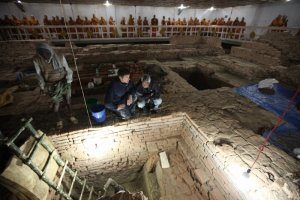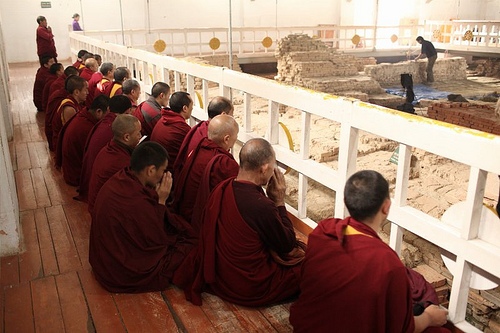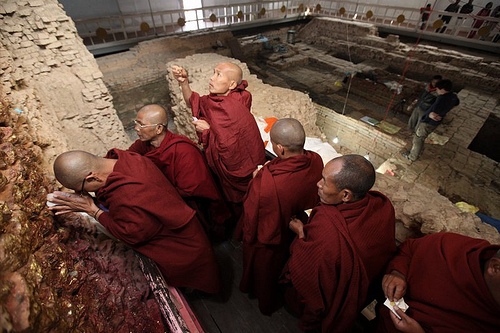 PERMITTED USE: This image may be downloaded or is otherwise provided at no charge for one-time use for coverage or promotion of National Geographic Buddha Birthplace and exclusively in conjunction thereof. Copying, distribution, archiving, sub-licensing, sale, or resale of the image is prohibited.REQUIRED CREDIT AND CAPTION: Any and all image uses must (1) be properly credited to the relevant photographer, as shown in this metadata, and (2) be accompanied by a caption which makes reference to of National Geographic Budda Birthplace.DEFAULT: Failure to comply with the prohibitions and requirements set forth above will obligate the individual or entity receiving this image to pay a fee determined by National Geographic. Photo by Ira Block/National Geographic Archaeologists Robin Coningham (left) and Kosh Prasad Acharya direct excavations within the Maya Devi Temple, uncovering a series of ancient temples contemporary with the Buddha. Thai monks meditate.
PERMITTED USE: This image may be downloaded or is otherwise provided at no charge for one-time use for coverage or promotion of National Geographic Buddha Birthplace and exclusively in conjunction thereof. Copying, distribution, archiving, sub-licensing, sale, or resale of the image is prohibited.REQUIRED CREDIT AND CAPTION: Any and all image uses must (1) be properly credited to the relevant photographer, as shown in this metadata, and (2) be accompanied by a caption which makes reference to of National Geographic Budda Birthplace.DEFAULT: Failure to comply with the prohibitions and requirements set forth above will obligate the individual or entity receiving this image to pay a fee determined by National Geographic. Photo by Ira Block/National Geographic Archaeologists Robin Coningham (left) and Kosh Prasad Acharya direct excavations within the Maya Devi Temple, uncovering a series of ancient temples contemporary with the Buddha. Thai monks meditate. Scientists excavating within the UNESCO World Heritage site of the Maya Devi Temple in Lumbini, Nepal, have unearthed a timber structure that they date to the sixth century BCE. It is situated within and underlies a temple that is considered sacred to many as the birthplace of Siddhārtha Gautama, or Buddha. Until now, there has been no archaeological evidence supporting a date any earlier than the third century BCE for Buddha’s life. Some historians have suggested the death of Buddha took place sometime in the late 4th century or early 3rd century BCE, although there are a number of traditions with varying dates.
“This sheds light on a very long debate,” said excavation co-leader Robin Coningham of Durham University, U.K.
Working amidst meditating monks, visiting pilgrims and nuns, the international team of archaeologists, led by Coningham along with Kosh Prasad Acharya of the Pashupati Area Development Trust in Nepal, discovered the timber structure remains while excavating under an overlying series of successive brick temples. To determine the dating of the timber structure, including a previously unknown first brick structure superimposed above it, charcoal and sand grain samples removed from the relevant layers of the early timber structure were tested using radiocarbon and optically stimulated luminescence techniques. Interestingly, geoarchaeological research also revealed evidence of ancient tree roots within the timber structure’s central space. This latter find is important because, according to Buddhist tradition, Queen Maya Devi, the mother of Buddha, gave birth to him while grasping a branch of a tree. Coningham and his colleagues suggest that the open central space from which the charcoal and sand samples were removed was large enough to accommodate the tree. Thus, concludes Coningham, “we have very clear evidence that this [timber] shrine was focused around the tree.” The later brick temples built over the timber structure, which was built around the open central space, were also arranged around this central space. Moreover, the results of their investigation indicated that the central space had “never been covered by a roof,” suggesting the significance of a space that clearly required special or unique treatment.
_______________________________________________________________________________________________________________________
Archaeologists Robin Coningham (left) and Kosh Prasad Acharya direct excavations within the Maya Devi Temple, uncovering a series of ancient temples contemporary with the Buddha. Thai monks meditate. Photo by Ira Block/National Geographic/National Geographic Buddha Birthplace
_______________________________________________________________________________________________________________________
Monks chant within the Maya Devi Temple at Lumbini in Nepal. The modern temple enshrines the birthplace of the Buddha. Photo by Ira Block/National Geographic/National Geographic Buddha Birthplace
_______________________________________________________________________________________________________________________
Pilgrims meditate at the wall below the nativity scene within the Maya Devi Temple at Lumbini, Nepal. The remains of the earliest temples at the site are in the background. Photo by Ira Block/National Geographic/National Geographic Buddha Birthplace
_______________________________________________________________________________________________________________________
Said Coningham: “Very little is known about the life of the Buddha, except through textual sources and oral tradition. We thought ‘why not go back to archaeology to try to answer some of the questions about his birth?’ Now, for the first time, we have an archaeological sequence at Lumbini that shows a building there as early as the sixth century B.C.”
Long lost and hidden by jungle overgrowth, ancient Lumbini was rediscovered in 1896 and, because of an inscription on a sandstone pillar discovered at the site, was identified as the birthplace of the Buddha. The inscription bears record of a historic visit by 3rd century India’s Emperor Ashoka to the site of the Buddha’s birth. The inscription also included the site’s name as Lumbini. Under Ashoka’s patronage, Buddhism spread from present-day Afghanistan to Bangladesh.
Other key historic sites related to Buddhism are Bodh Gaya, where Gautama became the Buddha; Sarnath, where he began his preaching; and Kusinagara, where he died.
Among the world’s major religions, Buddhism is followed by about 500 million people, with hundreds of thousands who make the pilgrimage to Lumbini annually.
_____________________________
The research was funded by the government of Japan in partnership with the government of Nepal under a UNESCO project for conserving and managing the Lumbini site. Funding was also provided by the National Geographic Society, Durham University, and Stirling University. The report details are published in the December 2013 issue of the international journal Antiquity.
A documentary on Coningham’s exploration of the Buddha’s life, “Buried Secrets of the Buddha,” will premiere in February internationally on National Geographic Channel.
____________________________
For an alternative perspective, an excellent and interesting commentary can be read about this discovery at The Subversive Archaeologist.
______________________________________________________________________________________________________________________
Read about the most fascinating discoveries with a premium subscription to Popular Archaeology Magazine. Find out what Popular Archaeology Magazine is all about, including the special Holiday Discount offer. AND MORE:
 Popular Archaeology’s annual Discovery edition is a selection of the best stories published in Popular Archaeology Magazine in past issues, with an emphasis on some of the most significant, groundbreaking, or fascinating discoveries in the fields of archaeology and paleoanthropology and related fields. At least some of the articles have been updated or revised specifically for the Discovery edition. We can confidently say that there is no other single issue of an archaeology-related magazine, paper print or online, that contains as much major feature article content as this one. The latest issue, volume 2, has just been released. Go to the Discovery edition page for more information.
Popular Archaeology’s annual Discovery edition is a selection of the best stories published in Popular Archaeology Magazine in past issues, with an emphasis on some of the most significant, groundbreaking, or fascinating discoveries in the fields of archaeology and paleoanthropology and related fields. At least some of the articles have been updated or revised specifically for the Discovery edition. We can confidently say that there is no other single issue of an archaeology-related magazine, paper print or online, that contains as much major feature article content as this one. The latest issue, volume 2, has just been released. Go to the Discovery edition page for more information.
Subscription Price: A very affordable $5.75 for those who are not already premium subscribers of Popular Archaeology Magazine (It is FREE for premium subscribers to Popular Archaeology). Premium subscribers should email [email protected] and request the special coupon code. Or, for the e-Book version, it can be purchased for only $3.99 at Amazon.com.







